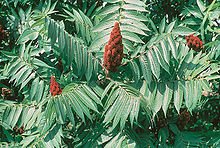Rhus typhina
| Rhus typhina | |
|---|---|

| |
| Staghorn sumac | |
| Scientific classification | |
| Kingdom: | |
| (unranked): | |
| (unranked): | |
| (unranked): | |
| Order: | |
| Family: | |
| Genus: | |
| Species: | R. typhina
|
| Binomial name | |
| Rhus typhina | |
Staghorn Sumac (Rhus typhina, synonym: R. hirta), is a deciduous shrub to small tree in the Anacardiaceae or Cashew family, native to eastern North America. It is primarily found in the Northeastern and Midwestern United States, Southern Ontario, and the Appalachian Mountains. [1]
It grows to 3-10 m tall, and has alternate, pinnately compound leaves 25-55 cm long, each with 9-31 serrate leaflets 6-11 cm long [2]. The leaf petioles and the stems are densely covered in rust-colored hairs.
The fruit of staghorn sumac is one of the most identifiable characteristics, forming dense clusters of small red drupes at the terminal end of the branches [2]; the clusters are conic, 10-20 cm long and 4-6 cm broad at the base. The plant flowers from May to July and fruit ripens from June to September. [2] The foliage turns a brilliant red in autumn. The fruit has been known to last through winter and into spring.
Staghorn sumac spreads using its seeds, and by spreading rhizomes. This makes it so the tree forms colonies, with the oldest plants in the center, and the younger plants radiating out [2]. It grows quite aggressively.
Cultivation and uses
Staghorn sumac grows in gardens, lawns, the edges of forests, and wasteland. It can grow under a wide array of conditions, but is most often found in dry and poor soil on which other plants cannot survive [2]. Some landscapers remove all but the top branches to create a "crown" effect in order to resemble a small palm tree.
The fruit of sumacs can be collected, soaked and washed in cold water, strained, sweetened and made into a pink lemonade [3]. The leaves and berries of staghorn sumac have been mixed with tobacco and other herbs and smoked by Native American tribes [4]. This practice continues to a small degree to this day [4].
All parts of the staghorn sumac, except the roots, can be used as both a natural dye and as a mordant. The plant is rich in tannins and can be added to other dye baths to improve light fastness. Harvest the leaves in the summer and the bark all year round. [5]
The cultivar 'Laciniata', Cutleaf Staghorn Sumac, is grown in gardens as an ornamental plant.
Photographs
-
Male flower cluster
-
Ripening drupes on June 11, 2007
-
Close up ripened drupes, July 2007
-
'Laciniata' Fruit on November 23, 2007
-
Dried "male" flower cluster on June 22, 2007
-
Fall colors
References
- [1] Germplasm Resources Information Network: Rhus typhina
- [2] Richard H. Uva, Joseph C. Neal and Joseph M. Ditomaso, Weeds of The Northeast, (Ithaca, NY: Cornell University Press, 1997), Pp. 326-327.
- [3] Lee Allen Peterson, Edible Wild Plants, (New York City: Houghton Mifflin Company, 1977), P. 186.
- [4] Cowasuck Band of the Pennacook-Abenaki People: The People of the White Pines: Smoking and Pipes
- [5] Jenny Dean, Wild Color: The Complete Guide to Making and Using Natural Dyes, (New York City: Watson-Guptill Publications, 1999), Pp. 123.
- Bioimages: Rhus typhina (as R. hirta)
External links
- Rhus
- Flora of New Brunswick
- Flora of Nova Scotia
- Flora of Ontario
- Flora of Prince Edward Island
- Flora of Quebec
- Flora of Connecticut
- Flora of Indiana
- Flora of Maine
- Flora of Massachusetts
- Flora of Michigan
- Flora of New Hampshire
- Flora of New Jersey
- Flora of New York
- Flora of Ohio
- Flora of Pennsylvania
- Flora of Rhode Island
- Flora of Vermont
- Flora of West Virginia
- Flora of Illinois
- Flora of Iowa
- Flora of Minnesota
- Flora of Wisconsin
- Flora of Alabama
- Flora of Delaware
- Flora of Georgia (U.S. state)
- Flora of Kentucky
- Flora of Maryland
- Flora of North Carolina
- Flora of South Carolina
- Flora of Tennessee
- Flora of Virginia









